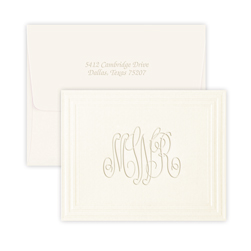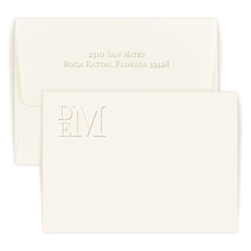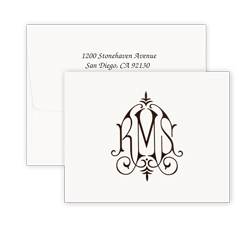Monogram Magic: Ancient History
You love your monogrammed stationery…it expresses your identity, connects you to tradition, and symbolizes your enjoyment of the good things in life. For all of these reasons, monogramming is undergoing a renaissance. But did you know how the monogram came to be “a thing”? In these next four posts, we look into the history of the monogram, its heyday in the Victorian era, as well as its meanings and contemporary uses.
In fact, the origins of the monogram go way back. Not on paper or even cloth: those are relatively recent applications. The first monograms were stamped on coins in ancient Greece. Along the way, monograms have bridged the gap between word and image to create potent symbols of identity and authenticity.
In Western culture, the earliest known monograms popped up on ancient Greek coins in around 300 B.C. (In Asian cultures, since their written characters do not stand for letter sounds, the monogram evolved a little differently.) The initials belonged to the private bankers, city-states or rulers that made the currencies, according to the online Handbook of Greek Coinage. In these early days of money, when issuers wanted people to trust using it, the monograms lent authenticity.
This practice of stamping coins with monograms continued for centuries, according to A Study of the Development of Monograms. For example, Constantine the Great, who founded Constantinople in 324 A.D. created one of the most famous monograms, a large P with an x through the stem. Another famous coin monogram belonged to the emperor Charlemagne. He liked it so much, he decided to use his monogram instead of his face on his coins.
Signatures, Buildings, Homes and Art
The history of the monogram continued as other uses developed. Does your Grandmother have a signet ring? It derives from the fancy signet rings rulers wore that allowed them to quickly sign documents using a blop of wax. Later, masons proudly carved their monograms or stone masons’ signs into new cathedrals.
Around this time, people like farmers and prominent citizens began monogramming their walls, prized equipment and even gravestones. These were called house marks.
Later in the 15th century, artists used monograms to sign their works. Italian potters created quite intricate and sometimes beautiful monograms on the bottoms of fine majolica vessels, according to Marks and Monograms on European and Oriental Pottery and Porcelain. And Renaissance painter Albrecht Dürer developed one of the more famous monograms, an attractive D under an A.
But the Victorians took monogramming to a whole new level. Tune in to the next post, where we explore “monogramania” in the 1800s.
Explore our lines of monogrammed Cards, Notes, Notepads, Napkins & Guest Towels, and all Monogrammed Items.
Sources:
A Study of the Development of Monograms: From Ancient Greek Coins to Contemporary Logos
Marks and Monograms on European and Oriental Pottery and Porcelain. William Chaffers. 14th edition. Borden Publishing Company, Los Angeles, CA.









